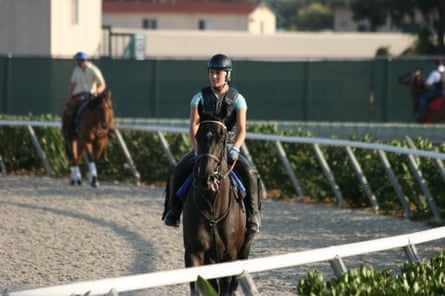
How computer-assisted wagering became horse racing’s insider trading
Cash-strapped racetracks are selling out everyday bettors to whales who use algorithms to wager huge sums at friendlier odds. It’s a rigged system designed for the rich to get richer
As the thoroughbred horse racing industry fades in America, I think back on the days when it was my life. I think a lot about what became of the thousands of horses I exercised. When I find myself locked in that headspace, the face of one kind little gelding haunts me. Dodgen Bullets, a Bob Baffert trainee, was no star and never going to be much as it was said, but he was willing and like all racehorses painfully innocent. We were young at the seaside in late summer at Del Mar racetrack, where this year’s Breeders’ Cup will be held over the the weekend. I exercised him into his first race, a Maiden Special Weight for two-year-olds which he won decisively. His connections pocketed over $50,000 in purse money and, aside from the $12 a day I made exercising him, I collected nearly $500 betting on his victory. As he was led back to the barn sweat-drenched, maybe frightened, I was clinking champagne and high on dopamine. These many years later I see how twisted my show of gratitude to him was.
Q&A
What is computer-assisted wagering and why is it controversial?
Show
Computer-assisted wagering (CAW) in thoroughbred racing uses algorithms and software to analyze vast data sets on horses, jockeys and races to make highly calculated bets, often placed by large teams or syndicates. CAW can predict odds fluctuations and identify betting inefficiencies, enabling large-scale, automated betting across multiple races and tracks. These systems often place wagers in real-time, sometimes only seconds before a race begins, putting the everyday punters who largely fund the betting pools at a disadvantage.
Despite that win I had no interest in gambling, was ignorant of the whole procedure, and fearful of losing the little money I had. Where I didn’t contribute to the handle, many other racetrackers did daily. It is a way for underpaid backside workers to shore up low wages. Over the last decade while poverty on the backside hasn’t much improved, and while horses are still endlessly churned through the industry without any mandated lifelong protection, track operators are exploiting the system to curate a more financially appealing landscape for themselves. Tracks like Del Mar serve up their retail customers, everyday bettors, to computer-assisted wagering (CAW) teams who use the wagering pools those customers create like a parasite does a host, and who work based off big figure deals with the tracks. Industry heavyweights like The Stronach Group, New York Racing Association, and Churchill Downs own the platforms these teams use to gamble on. Scott Daruty, president of Stronach-owned gambling entities Monarch Content Management and Elite Turf Club, said he does not see a conflict because ownership gives track operators “a direct relationship with our biggest customers”, and “an understanding that we wouldn’t have were middlemen conducting this activity”, so it is “the right thing in my opinion”, he told California Horse Racing Board commissioners.
The greatest advantage these nerd cliques receive over the grandparents who bet on weekends, the broke student, or the backside worker is through special rates and significant rebates tied to their track deals. According to Pat Cummings, executive director of the National Thoroughbred Alliance who spoke to horsemen on a panel in July, CAWs use “finely honed systems, algorithms that sense vast amounts of data and place their bets in very quick fashion, oftentimes right before the race begins … they are able to batch bet”. The average bettor’s weakness is the CAWs target for profit but it is a balance because without the average bettor sustaining the pool the CAW model fails.
While CAW play has grown in recent years, run-of-the-mill wagering has not. In fact in the last two decades non-CAW wagering is down by two-thirds while a dozen or so “high frequency bettors” constitutes about one third of all betting on US thoroughbred racing, Cummings said at a Jockey Club panel discussion. Cummings says his research indicates there are “10 or 12 top-tier players in America who are using this approach. … Those 10 to 12 players probably represent somewhere between $2bn to $3bn of US thoroughbred racing’s $11.6bn wagered last year [2023].” Many bettors say they think those are conservative estimates. Another strongly shared belief among average bettors is that CAWs also receive internal pool information that further boosts their advantages. It is an area ripe for investigations into potential gaming laws violations and so very racetrack.

Horse racing as it has existed in North America is dying and as a track friend grimly described, the tracks are “inviting vultures to pick the bones of the carcass”. It is hard to know what American tracks would look like fiscally if CAW play ceased. Moving forward there is not nearly enough public love to resurrect this relic of a sport to its former self. Contraction is everywhere from the long ongoing trends of declining foal crops to the shorter fields and reduction in race dates, and the subsequent shuttering of tracks across the nation. Even the famous Santa Anita Park is sounding its death rattle.
The future for US horse racing is probably boutique. New York tracks and Churchill Downs will survive on select expensive race days nestled within short meets. It is unfortunate for horses but racing in a few states like Louisiana will likely live on simply because they operate with unapologetic lawlessness.
Dodgen Bullets ran a total of 17 races, winning three, and making just over $80,000. His career was a slow descent into the bottom ranks of the sport with his final race at the low-rent Los Alamitos Quarter Horse Track in 2011 less than four years after his shining Del Mar debut. He finished last in a $7,000 claiming race. A far cry from running for the barn of one of the most well-known racehorse trainers in history. His fate after that day is anyone’s guess. No one horse from my past lingers with me like he does, and I admit I feel shame burying his memory in an article about gambling. But it was the world we shared. He was an everyday racehorse who like the everyday bettor kept thoroughbred racing alive in spite of itself. Like those bettors though, he was never going to finish on the lead because the game is designed to take until there is nothing left, then turn its back on the ruin and move on.
